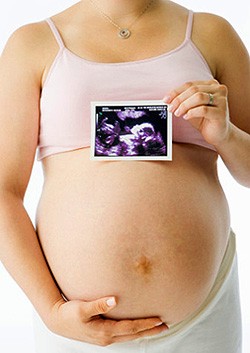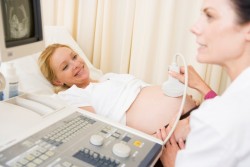Description of pathology
With normally proceeding pregnancy, the placenta is located in the upper part of the uterus (in the umbilic day), thereby not overlaps the generic paths and allows the child the first to appear. It happens that the fruit egg is attached to the wall of the mucous membrane in such a way that the placenta, increasing in the amount, partially or completely overlaps the child. Woman with the prepayment of the placenta can not always give birth on his own and do it cesarean section.
Types of prelation of the placenta

In total, there are 3 types of placenta prelations depending on its location relative to the internal zea:
- Central (complete) preview - with this location, the internal zev completely overlaps the placenta. This is the most dangerous type of prelation, in which the birth is naturally impossible even with the full opening of the cervix - the child's head will not be able to enter the labor paths, closed by the placenta. This type of childhood location is fixed by more than 20% of all cases of pathology. A woman who is given such a diagnosis is rapidly over a period of 36-37 weeks.
- Partial presence - in this case, the placenta does not completely overlap the inner zev, some part of it remains open. This type of location is two types:
- Regional prediction - when the placenta overlaps a smaller part of the inner zone, while only the fetal shells can be recognized in the cerulmonary channel;
- Side prediction - the placenta is located so that its part overlaps the cervical canal.
- With this location of the child's place, natural childbirth is possible, but in each individual case, the doctor can make a decision only after a thorough examination of pregnant.
- The low layout of the placenta - with such a pre-selection of the placenta, it may not be at the very bottom of the uterus, as it should be in normal pregnancy, but not closer to 6 cm for internal zev. With such an abnormality, there is always a chance that the placenta will be tightened closer to the bottom of the uterus during growth, then natural labor will be absolutely safe. It is at low placenta that a child's migration is possible into a more prosperous place of localization.
In addition to these 3 main types of abnormal placenta, 2 more types of partial or low prerequisites are distinguished:
- Front preview - In this case, some of the placenta is attached on the front wall of the uterus.
- Rear preview - Most of the placenta is localized over the back of the uterus.
These two types of location are not considered pathology and do not carry a threat to the successful completion of labor. In most cases, the placenta in the process of growth is tightened to the bottom of the uterus and by the time of birth occupies normal.
Causes of abnormal placenta
When a fetal egg falls into the uterine cavity, it chooses the safest and most favorable place for its growth and development. Such a plot is the one on which the endometrial layer above, there are no scars or formations. Sometimes this site is in the segment in which the further development of the fetus will lead to an abnormal location of the placenta. The reasons that lead to such an egg mount are characterized by several factors. These factors doctors combined in 2 groups:
- Factors dependent on the health of the future mother. These include:
- Operations that have suffered a woman before the start of pregnancy - Abortion Surgical and medication, caesarean cross-section, scraping according to indications, removal of fibromyomoma or Moma uterus, removal of malignant formations, manual intervention with previous birth and any other surgical interventions that can leave scars on the mucous membrane of the uterus;
- myoma and fibromyoma;
- Endometriosis (the growth of endometrial cells);
- chronic and acute endometrite;
- Pathology of the uterus (underdevelopment, improper structure);
- Chronic Eastic Cervical Insufficiency;
- Multiple pregnancy;
- multiple childbirth (more than 3);
- The pathological structure of the neck (bend) and inflammatory processes of the cervix caused by infections (dysplasia);
- Alcohol abuse I smoking;
- Age of a woman is 35 years old and older;
- Other diseases accompanied by a violation of blood supply due to which it occurs in the pelvic bodies.
- Factors that depend on the peculiarities and state of the fetal egg. Such factors are:
- Uneximinary implantation of a fetal egg into the mucous meter after its omission in the uterine cavity.
Symptoms and signs of the presence of a kindergarten

The diagnosis of this pathology is carried out on the basis of clinical manifestations and additional research:
- If the doctor during inspection suspected an abnormal location of the placenta, he must send a woman to Ultrasound. The bimanual inspection of the vagina is not recommended to avoid the occurrence of bleeding, which can cause premature birth.
- In case of impossibility of holding an ultrasound, the doctor must very carefully conduct a pregnant vagina. If the diagnosis is confirmed, the woman urgently is hospitalized.
Methods for treating the prelation of the placenta

Treatment methods are selected depending on several factors:
- With strong bleeding in the later dates, the pregnancy is not preserved, and resort to surgical delivery - Cesarean cross section.
- If bleeding begins after 24 weeks, but there is a threat to the life of the future mother, an urgent surgical delivery is also carried out.
- In case of non-bleeding, which occurs after 24 weeks and stops in itself, the woman goes to the hospital treatment. It is carried out by the therapy of the following character:
- Antispasmodics and relaxing drugs are introduced intravenously or intramuscularly (But-shp, Papaverine, Magnesia);
- With violation of gas exchange prescribed Kuraltil, Askorutin, fat-soluble or tableted vitamin E, folic acid;
- Vitamins in groups are introduced intramuscularly;
- Iron-containing drugs for increasing hemoglobin (ferumlex, totem) plus a special diet consisting of rich iron products;
- In addition to treating medication, a bed is appointed bed. No loads, stress and nerve breaks should be.
In addition, a woman with this diagnosis is contraindicated by sex of any kind to avoid cutting.
Prevention prevention

To avoid complications during pregnancy, a woman must follow her health from early youth:
- Remember that frequent supercooling leads to inflammatory processes in the small pelvis organs.
- Woman should lead a healthy lifestyle, not smoking, not to take drugs, avoid random connections to avoid infection of STIs.
- Our site recommends a survey from specialists to identify chronic diseases that can negatively affect pregnancy.
- Each girl should know that early abortions can lead to any pathology during pregnancy.









